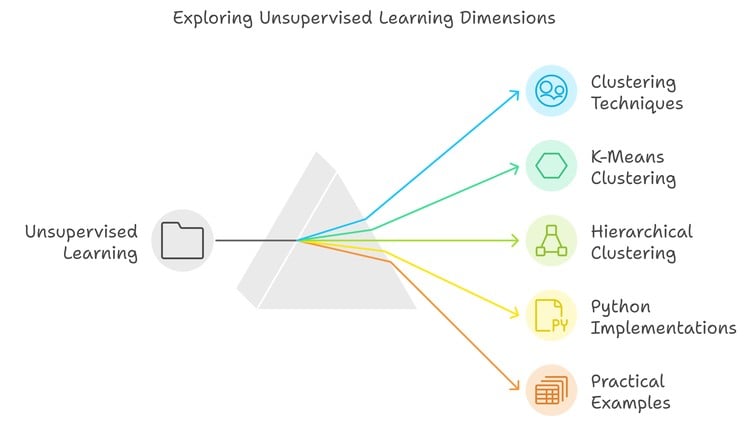
Unsupervised Learning & Clustering: K-Means, Hierarchical, DBSCAN, GMM, PCA for Data Science & ML Mastery.
👥 20 students
Add-On Information:
Note➛ Make sure your 𝐔𝐝𝐞𝐦𝐲 cart has only this course you're going to enroll it now, Remove all other courses from the 𝐔𝐝𝐞𝐦𝐲 cart before Enrolling!
-
Certified Unsupervised Learning & Clustering Course Description
-
Course Overview
- This “Certified Unsupervised Learning & Clustering” program is an intensive journey into discovering hidden patterns and structures within unlabeled data, crucial for modern Data Science and Machine Learning. It provides the essential methodologies to transform raw information into actionable intelligence, positioning you as a master of data exploration.
- The course meticulously balances theoretical foundations with extensive practical implementation. Participants will engage in hands-on projects, applying industry-standard algorithms and tools to real-world datasets, ensuring immediate skill translation and portfolio development.
- With an exclusive limit of 20 students, this small cohort guarantees a highly personalized and interactive learning experience. This intimate setting allows for direct instructor engagement, tailored feedback, and collaborative peer learning, maximizing individual progress.
- Earning this certification signifies a validated expertise in unsupervised learning, recognized by the industry. It attests to your ability to confidently apply advanced clustering and dimensionality reduction techniques in professional environments.
-
Requirements / Prerequisites
- Foundational knowledge of Python programming, including basic data structures, control flow, and function definitions.
- Basic understanding of mathematics and statistics, encompassing concepts like mean, variance, and an intuitive grasp of vectors and matrices.
- Familiarity with fundamental Machine Learning concepts, such as the distinction between supervised and unsupervised learning, and general model evaluation principles.
-
Skills Covered / Tools Used
- K-Means Clustering Mastery: Implement and optimize K-Means, K-Medoids, and MiniBatch K-Means. Learn techniques for determining optimal ‘K’ values using methods like the Elbow Method and Silhouette Analysis, understanding its centroid-based partitioning logic for effective data segmentation.
- Hierarchical Clustering Proficiency: Explore Agglomerative and Divisive Hierarchical Clustering, mastering various linkage criteria (Ward, Complete, Average) and distance metrics. Learn to interpret dendrograms for effective cluster visualization and selection, uncovering nested structures.
- DBSCAN (Density-Based Spatial Clustering of Applications with Noise) Expertise: Gain hands-on experience with DBSCAN for identifying arbitrarily shaped clusters and effectively handling noise. Understand its core parameters (epsilon, min_samples) and its advantages over centroid-based methods in specific datasets, crucial for anomaly detection.
- Gaussian Mixture Models (GMM) Application: Dive into probabilistic clustering with GMM, understanding its expectation-maximization (EM) algorithm. Learn to model clusters as multivariate Gaussian distributions, providing a more flexible and robust approach than hard-assignment clustering, especially with overlapping clusters.
- Principal Component Analysis (PCA) for Dimensionality Reduction: Master PCA as a powerful technique for reducing the dimensionality of complex datasets while preserving maximum variance. Understand eigenvalue decomposition, singular value decomposition (SVD), and how to apply PCA for effective data visualization and preprocessing for other ML algorithms.
- Python Programming with Core Libraries: Solidify your Python skills by extensively using `NumPy` for numerical operations, `Pandas` for robust data manipulation and analysis, and `Matplotlib` and `Seaborn` for creating insightful, presentation-ready data visualizations.
- Scikit-learn Framework: Become adept at utilizing `Scikit-learn`, the industry-standard machine learning library in Python, to implement, fine-tune, and evaluate all covered unsupervised learning and dimensionality reduction algorithms with production-ready code.
- Feature Engineering & Preprocessing for Unsupervised Learning: Acquire best practices for preparing data for clustering, including advanced scaling techniques (StandardScaler, MinMaxScaler), handling missing values, and encoding categorical features, all crucial for effective unsupervised analysis and optimal algorithm performance.
-
Benefits / Outcomes
- Uncover Hidden Data Patterns: Develop the ability to independently discover meaningful structures, segments, and intrinsic relationships within large, unlabeled datasets, transforming raw information into actionable business intelligence.
- Master Advanced Data Exploration & Anomaly Detection: Go beyond basic descriptive statistics to perform sophisticated exploratory data analysis using clustering and dimensionality reduction, leading to deeper insights and robust identification of outliers, critical for fraud detection and quality control.
- Optimize ML Workflows with Dimensionality Reduction: Skillfully apply PCA to simplify complex datasets, mitigate the curse of dimensionality, and prepare data efficiently for downstream machine learning tasks, significantly improving model performance and interpretability.
- Build a Robust ML Portfolio & Achieve Certification: Complete the course with practical, deployable projects demonstrating your proficiency in various unsupervised learning techniques, creating tangible evidence of your skills, and earning a recognized “Certified Unsupervised Learning & Clustering” credential.
- Catalyze Career Advancement: Position yourself for high-demand roles requiring advanced data analysis, such as Data Scientist, Machine Learning Engineer, Business Intelligence Analyst, or Research Scientist, by mastering a critical and industry-validated skill set.
-
PROS of this Course
- Small Class Size (20 Students): Guarantees highly personalized attention and direct interaction with expert instructors.
- Practical & Hands-on Learning: Focuses on real-world applications and project-based assignments, building immediate, deployable skills.
- Comprehensive Algorithm Coverage: Explores a wide array of essential unsupervised learning and dimensionality reduction algorithms.
- Industry-Recognized Certification: Provides a valuable credential that validates your expertise and significantly boosts career prospects.
- Expert-Led Instruction: Learn from experienced practitioners who bring real-world insights and best practices into the classroom.
- Strong Foundation for Advanced ML: Establishes a crucial understanding for tackling more complex machine learning challenges.
-
CONS of this Course
- Significant Time Commitment Required: The comprehensive nature and extensive hands-on demands of the course necessitate a considerable investment of time and dedication outside of scheduled sessions.
Learning Tracks: English,IT & Software,Other IT & Software
Found It Free? Share It Fast!